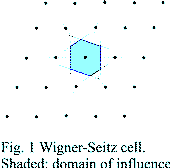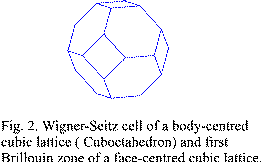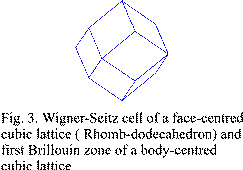Wigner-Seitz cell
From Online Dictionary of Crystallography
Revision as of 12:24, 25 January 2006 by BrianMcMahon (talk | contribs)
Wigner-Seitz cell
Other languages
Maille de Wigner-Seitz (Fr). Wigner-Seitz Zell (Ge). Celda de Wigner-Seitz (Sp).
Definition
The Wigner-Seitz is a a polyhedron obtained by connecting a lattice point P to its closest neighbours and drawing the planes perpendicular to these connecting lines and passing through their midpoints (Fig. 1). This construction is called the Dirichlet construction. The cell thus obtained is a primitive cell and it is possible to fill up the whole space by translation of that cell.
The Wigner-Seitz cell of a body-centred cubic lattice I lattice is a cuboctahedron and the Wigner-Seitz cell of a face-centred cubic lattice F is a rhomb-dodecahedron. In reciprocal space this cell is the first Brillouin zone. Since the reciprocal lattice of body-centred lattice is a face-centred lattice and reciprocally, the first Brillouin zone of a body-centred cubic lattice is a rhomb-dodecahedron (Fig. 2) and that of a face-centred cubic lattice is a cuboctahedron (Fig. 3).
The inside of the Wigner-Seitz cell has been called domain of influence by Delaunay (1933). It is also called Dirichlet domain or Voronoi domain. The domain of influence of lattice point P thus consists of all points Q in space that are closer to this lattice point than to any other lattice point or at most equidistant to it (such that OP ≤ |t - OP| for a any vector t belonging to the vector lattice L).
See also
Section 9.1 of International Tables of Crystallography, Volume A Section 1.5 of International Tables of Crystallography, Volume B


